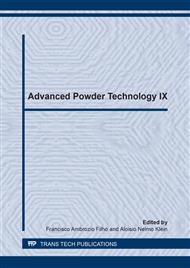p.274
p.280
p.285
p.291
p.297
p.303
p.311
p.317
p.323
Analysis of the Collection Efficiency of Fiber Filters on the Filtration of Nano-Sized Particles from Aerosol
Abstract:
Several studies on removal of nanosized particles are being developed with the aim of minimizing the adverse effects nanoaerosols can cause to the environment and human health due to poor air quality. Moreover, scientific and technological studies have developed in the application of nanosized particles. In academy and industry there are many mechanisms to remove nanoparticles from aerosols, such as fiber filters. Thus, this study aims to analyze the performance of fibrous filters, such as polyester filters (porosity is 0.82 and thickness is 2.2 mm and fiber mean diameter of 26 μm. A nanoparticle generator constitutes an atomizer that was used to generate nanoaerosols of monodisperses polystyrene latex) in a size distribution from 20 nm to 200 nm. The performance of the fibrous media was evaluated through the analysis of removal efficiency of nanoaerossols, using a particle counter TSI model 3007 before and after the filtering device. The experimental system consists of a compressor, which generates air current; high efficiency filters, in order to generate ultra-pure air; an atomizer and a container of polystyrene solution to generate aerosol; diffusion dryer to remove silica humidity from the gas stream; a filtration device; and, a counter to particles. The results obtained showed that the efficiency of a filter decreases with increasing filtration rate and diameter in the range in work. The diffusion mechanism is dominant in the separation process.
Info:
Periodical:
Pages:
297-302
Citation:
Online since:
December 2014
Price:
Сopyright:
© 2014 Trans Tech Publications Ltd. All Rights Reserved
Share:
Citation:


